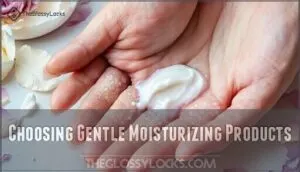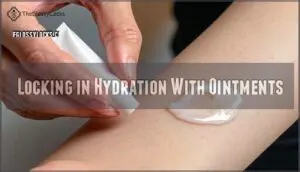This site is supported by our readers. We may earn a commission, at no cost to you, if you purchase through links.
 You can heal dry flaky skin by moisturizing immediately after bathing while your skin’s still damp.
You can heal dry flaky skin by moisturizing immediately after bathing while your skin’s still damp.
This locks in water like a protective shield.
Switch to gentle, fragrance-free cleansers and take shorter, lukewarm showers instead of scalding hot ones.
Apply a thick moisturizer containing ceramides or hyaluronic acid twice daily.
Think of your skin barrier as a brick wall – when it’s damaged, moisture escapes through the cracks.
Add a humidifier to your bedroom and drink plenty of water.
Avoid harsh soaps that strip natural oils.
Your skin should start feeling smoother within a few days of consistent care.
The secret lies in understanding which specific ingredients work fastest.
Table Of Contents
- Key Takeaways
- Dry Flaky Skin Causes
- Healing Dry Flaky Skin
- Moisturizing Techniques
- Preventing Dry Skin
- Bathing and Cleansing
- Natural Remedies
- Managing Dry Skin
- Frequently Asked Questions (FAQs)
- How do you get rid of dry flaky skin?
- How to fix dry, flaky skin down there?
- How long does it take for dry flaky skin to heal?
- Is vaseline good for dry flaking skin?
- How long does dry skin take to heal?
- Can certain fabrics worsen dry flaky skin?
- Is dry skin contagious to other people?
- What makeup products are safe for dry skin?
- Should I exfoliate dry flaky skin patches regularly?
- Conclusion
Key Takeaways
- You’ll heal dry flaky skin fastest by moisturizing immediately after bathing while your skin’s still damp – this locks in moisture like a protective barrier and prevents water loss throughout the day.
- Switch to lukewarm showers instead of hot ones and use gentle, fragrance-free cleansers to avoid stripping your skin’s natural oils that keep it hydrated and protected.
- Look for moisturizers containing ceramides or hyaluronic acid and apply them twice daily – these ingredients rebuild your skin’s protective barrier from within and provide long-lasting hydration.
- You can prevent future dryness by maintaining indoor humidity around 60%, wearing protective clothing in harsh weather, and staying properly hydrated with 8-10 glasses of water daily to rebuild your skin.
Dry Flaky Skin Causes
Your skin becomes dry and flaky when it loses too much moisture or can’t retain adequate hydration.
When your skin can’t hold onto moisture, dryness and flaking become inevitable—but understanding why helps you fight back.
Several factors contribute to this condition, including environmental elements like cold weather and low humidity, the natural aging process that reduces oil production, harsh soaps that strip away protective oils, and underlying medical conditions such as eczema or psoriasis.
Environmental Factors
When your environment works against you, dry flaky skin becomes inevitable.
Climate effects like low humidity strip moisture from your skin, while seasonal changes during winter months create the perfect storm for dehydration.
Pollution impact damages your skin’s protective barrier, and sun exposure accelerates moisture loss.
Even occupational hazards like air conditioning affect skin hydration, making consistent moisturizing essential for proper skin care.
Aging Skin
Time takes its toll on your skin’s natural defense system.
As you age, your body produces less oil and loses its ability to retain moisture effectively.
Here’s what happens to aging skin:
- Reduced Sebum production means less natural oil protection
- Collagen Loss leads to thinner, more fragile skin layers
- Elasticity Decline causes skin to lose its bounce-back ability
- Wrinkle Formation creates crevices where moisture escapes easily
Harsh Soaps and Cleansers
Many soaps contain harsh ingredients that strip your skin’s protective barrier, leading to dryness and flaking.
Check product labels for sulfates, alcohol, and artificial fragrances—common culprits behind allergic reactions and irritation.
Sensitive skin requires fragrance-free soaps with balanced cleanser pH levels.
For dry skin, cream cleansers offer hydration while still cleansing.
Switch to gentle, moisturizing alternatives for effective dry skin treatment without compromising your skin’s natural oils.
Underlying Medical Conditions
Several chronic conditions can trigger persistent flaky skin that won’t respond to basic moisturizers.
Diabetes disrupts your skin’s hydration through poor circulation, while thyroid disorders reduce natural oil production by half.
Eczema and psoriasis create ongoing inflammation that damages your skin barrier.
These underlying skin conditions require targeted eczema treatment and psoriasis management beyond standard skincare routines.
Understanding the causes of scaly skin is key to effective treatment.
Healing Dry Flaky Skin
Understanding flaky skin causes helps you target the right healing approach. Your skin needs immediate relief and long-term repair to bounce back from dryness and irritation.
Start with gentle exfoliation techniques to remove dead skin cells without causing further damage. Use a soft washcloth or chemical exfoliant with lactic acid once weekly. This prepares your skin to absorb healing treatments more effectively.
Focus on skin barrier repair through ingredients like ceramides and niacinamide. These compounds rebuild your skin’s protective layer from the inside out. Apply repair serums before moisturizing for maximum benefit. One helpful approach is to use skin slugging overnight to lock in moisture.
Consider dietary supplements like omega-3 fatty acids and vitamin E to support healing from within. Professional treatments such as hydrating facials can provide intensive skin hydration tips when home remedies aren’t enough.
Don’t overlook stress management – chronic stress worsens skin conditions and slows healing. Practice relaxation techniques to help your skin recover faster.
Moisturizing Techniques
Proper moisturizing techniques form the foundation of treating dry, flaky skin and require specific timing and product selection to maximize effectiveness.
The secret to healthy skin isn’t expensive creams—it’s mastering the art of moisture timing and smart product choices.
You’ll achieve the best results by applying moisturizers immediately after bathing while your skin is still damp, which helps trap water and creates a protective barrier against moisture loss.
Applying Moisturizer After Bathing
Right after stepping out of your shower, you’ve got a golden window for maximum moisturizer absorption.
Apply your chosen skin hydration products while your skin’s still damp – this locks in moisture like a sponge.
The application timing matters more than product types, and this simple skin care routine trick boosts skin barrier repair and keeps your skin hydrated longer.
Using Humectant-Based Moisturizers
Humectants work like magnets for moisture, pulling water from the air into your skin.
Glycerin effectiveness shines as it binds water molecules directly to skin cells.
Look for moisturizers containing ceramides and hyaluronic acid with low pH formulations.
These skin hydration products strengthen your skin barrier while preventing water loss.
The skin’s lipid matrix is essential for preventing transepidermal water loss.
Apply humectant-based moisturizers twice daily for ideal results.
Choosing Gentle Moisturizing Products
Looking for the right moisturizer feels overwhelming with countless options.
Start with fragrance-free products designed for sensitive skin to avoid irritation. Read ingredient analysis labels carefully, avoiding alcohol and harsh chemicals.
Test new skin care products on a small patch first. Consider using products for sensitive skin for best results.
Budget options work just as well as expensive creams when they contain effective moisturizing ingredients like ceramides and glycerin.
Locking in Hydration With Ointments
Thick ointments create a protective seal that traps moisture against your skin like a waterproof barrier.
Unlike creams, petroleum jelly and petrolatum-based products don’t evaporate, making them incredibly effective for healing cracked, flaky patches.
- Ointment application: Apply a thin layer to damp skin for maximum absorption
- Ointment ingredients: Look for petrolatum, lanolin, or mineral oil bases
- Ointment effectiveness: Works overnight to restore your skin barrier completely
Preventing Dry Skin
You can stop dry skin before it starts by making simple changes to your daily routine and environment.
Preventing dry skin is easier than treating it, and these protective measures will keep your skin healthy year-round, by making simple changes to maintain a healthy skin.
Maintaining Indoor Humidity
Indoor air becomes your skin’s enemy during winter months when heating systems strip moisture from your environment.
Set your humidifier to maintain ideal humidity levels around 60% to combat winter skin dryness.
Monitor humidity with a simple gauge to verify optimal skin moisture.
This simple environmental adjustment strengthens your skin barrier against harsh conditions while supporting overall health benefits.
Wearing Protective Clothing
Shield your skin from harsh weather conditions by choosing the right clothing materials and layering strategies. Cotton and silk fabric choices allow your skin to breathe while providing essential sun protection against UV damage that worsens winter skin dryness.
Essential protective clothing tips:
- Wear gloves during cold weather to prevent itchy skin relief needs
- Choose loose-fitting fabrics to avoid skin irritation
- Layer breathable materials for superior skin care protection, which is crucial for maintaining healthy skin and preventing dryness.
Avoiding Harsh Chemicals
Beyond clothing protection, your product choices matter just as much.
Check product labels for harsh chemicals like sulfates, alcohol, and artificial fragrances that strip your skin’s natural oils.
Switch to fragrance-free soaps and gentle laundry detergent to prevent allergic reactions.
Choose dish soap with natural ingredients for sensitive skin.
Irritant identification helps you find better chemical alternatives, which is crucial for fragrance-free and sensitive skin care.
Staying Hydrated
Proper water intake forms the foundation of healthy skin from within.
Your body’s electrolyte balance directly affects how well your skin retains moisture and maintains its protective barrier.
Smart hydration monitoring supports your skin care routine tips:
- Drink 8-10 glasses of water daily for ideal skin hydration
- Choose herbal teas over caffeinated beverages for better hydrating choices
- Include hydrating foods like watermelon and cucumber in meals
- Monitor urine color to gauge hydration levels
- Balance electrolytes with natural sources like coconut water
By following these skin care routine tips and maintaining a balance of electrolytes, you can support your skin’s natural barrier and overall wellness.
Bathing and Cleansing
Your daily bathing routine can either help heal your dry, flaky skin or make it worse, depending on how you approach it.
The key lies in making simple adjustments to your water temperature, soap choice, and bathing frequency to protect your skin‘s natural moisture barrier.
Limiting Bathing Frequency
Daily showers might feel invigorating, but they’re stripping your skin’s natural protective oils.
You don’t need a full bath or shower every day. Try showering alternatives like sponge baths for quick cleansing or targeted washing of specific areas.
Use dry shampoo between washes. This approach helps preserve your skin’s moisture barrier while maintaining cleanliness.
Using Lukewarm Water
Hot water might feel relaxing, but it’s your skin’s worst enemy.
Lukewarm water preserves your skin barrier while still providing effective gentle cleansing. This ideal water temperature maintains your natural hydration levels without stripping essential oils.
When you moisturize dry skin after bathing, lukewarm water helps lock in moisture. Follow these skin care tips to soothe irritated skin naturally, using lukewarm water to help with gentle cleansing and moisturize dry skin.
Selecting Mild Cleansers
Your cleanser can make or break your skin’s healing journey.
Swap harsh soaps for fragrance-free alternatives that respect your skin’s natural pH balance. Look for gentle cleansing oils or soap-free cleansers with minimal ingredients—your sensitive skin will thank you.
Dermatologist advice consistently points to mild formulations that cleanse without stripping. Many people find relief using specially formulated cleansers.
These skin care tips protect your barrier while removing dirt, which is crucial for maintaining healthy skin with a natural pH balance.
Avoiding Hot Showers
Your shower routine plays a bigger role in dry skin than you might think.
Hot showers strip away your skin’s natural protective oils, leaving you with that tight, flaky feeling afterward.
Water temperature matters more than most people realize for maintaining healthy skin.
- Keep water temperature lukewarm rather than steaming hot
- Limit shower duration to 5-10 minutes maximum
- Choose gentle, fragrance-free cleansers over harsh soaps
- Consider bath alternatives like quick rinses on particularly dry days
Natural Remedies
You don’t need expensive treatments to heal dry, flaky skin when your kitchen pantry contains proven natural remedies.
Simple ingredients like coconut oil, oatmeal, and petroleum jelly can restore moisture and repair your skin barrier effectively.
Coconut Oil Benefits
Coconut oil’s fatty acid benefits make it a powerhouse for dry skin relief.
Its medium-chain fatty acids penetrate deeply, providing coconut oil hydration that lasts up to 24 hours.
You can safely use this natural moisturizer on sensitive skin areas, including around your eyes.
Explore related products here for enhanced hydration.
Simply apply pure coconut oil daily as part of your skin remedies routine for effective everyday use.
Petroleum Jelly Uses
Many dermatologists recommend petroleum jelly as an effective barrier treatment for dry, flaky skin conditions.
Its occlusive properties create a protective seal that prevents moisture loss and supports wound healing processes.
- Eczema relief: Apply thin layers to inflamed patches for soothing protection
- Chapped lips: Use as overnight treatment for severe cracking and peeling
- Nail care: Massage around cuticles to prevent dryness and splitting
Colloidal Oatmeal Soaks
Ground oats into fine powder for your DIY Oatmeal Soak that transforms irritated skin.
Colloidal oatmeal’s anti-inflammatory compounds provide immediate itch relief while binding moisture to your skin barrier.
Add the powder to lukewarm bathwater and soak for 10-15 minutes.
This gentle, natural remedy soothes dry flaky skin without harsh chemicals, making it perfect for sensitive areas, providing immediate itch relief.
Antioxidant-Rich Foods
Your diet plays a bigger role in skin health than you might think.
Antioxidant benefits from specific foods help your body fight toxins that damage skin cells.
These nutrients support healthy cell production and reduce inflammation that worsens dry skin conditions.
A diet rich in antioxidants can also help combat collagen breakdown effects.
- Blueberries packed with vitamin C and anthocyanins that protect skin cells
- Salmon rich in omega-3 fatty acids for natural moisture barrier support
- Carrots loaded with beta-carotene that converts to skin-repairing vitamin A
- Tomatoes containing lycopene that shields skin from environmental damage
- Beans and lentils providing zinc and protein for tissue regeneration
Managing Dry Skin
Managing dry skin effectively requires a thorough approach that addresses both immediate symptoms and underlying causes.
You’ll need to combine proper identification of contributing factors with consistent treatment strategies to achieve lasting results, which is crucial for effective management.
Identifying Underlying Conditions
Sometimes persistent dry skin signals deeper health issues that need attention.
Your healthcare provider will conduct a thorough skin examination and review your medical history to identify potential causes.
They’ll assess lifestyle factors and may order diagnostic tests if needed.
| Assessment Type | What It Reveals |
|---|---|
| Skin Examination | Visual signs of skin conditions, irritation patterns |
| Health History | Previous skin diagnosis, family history of skin conditions |
| Lifestyle Factors | Environmental triggers, product sensitivities |
| Diagnostic Tests | Underlying conditions causing skin inflammation |
| Medical History | Medications or health issues affecting skin |
Using Topical Treatments
Topical treatments offer targeted relief when basic moisturizers aren’t enough.
Prescription creams containing ceramides and hyaluronic acid restore your skin’s protective barrier, while medicated lotions with glycerin provide deep hydration.
For severe cases, doctors may recommend steroid use or anti-itch solutions.
Petroleum jelly creates an occlusive seal, locking moisture in overnight for accelerated healing.
Maintaining a Balanced Diet
Beyond topical treatments, your skin health depends heavily on what you eat.
A balanced diet rich in omega-3 intake and antioxidant sources can substantially reduce diet & inflammation while supporting natural skin remedies from within.
Your skin-healthy foods should include:
- Fatty fish – salmon and sardines for omega-3s
- Colorful vegetables – carrots, tomatoes for antioxidants
- Legumes – beans, lentils for protein
- Berries – blueberries for skin protection
- Water – adequate hydration importance for moisture
Getting Sufficient Sleep
Quality rest isn’t just beauty sleep—it’s essential medicine for your skin.
During deep sleep, your body prioritizes cellular repair and skin regeneration, reducing stress hormones that trigger inflammation.
Aim for seven to nine hours nightly to support ideal skin health.
Poor sleep duration disrupts your skin care regimen‘s effectiveness, making even the best skin care practices less beneficial for healing dry, flaky patches.
Effective dry skin relief methods also involve a consistent nighttime skincare routine to lock in moisture and support the skin’s natural barrier function.
Frequently Asked Questions (FAQs)
How do you get rid of dry flaky skin?
Apply moisturizer to damp skin immediately after lukewarm showers.
Use gentle, fragrance-free cleansers and limit bathing time. Pat skin dry instead of rubbing.
Consider coconut oil or petroleum jelly for extra hydration.
How to fix dry, flaky skin down there?
Dealing with intimate dryness feels like your body’s betraying you.
Use gentle, fragrance-free moisturizers designed for sensitive areas. Apply after bathing while skin’s damp.
Avoid harsh soaps and consider seeing a healthcare provider for persistent issues.
How long does it take for dry flaky skin to heal?
Dry, flaky skin typically heals within one to two weeks with consistent moisturizing.
You’ll notice improvement in three to five days.
Severe cases may take longer, so stick with your routine and be patient.
Is vaseline good for dry flaking skin?
Like a protective shield for parched skin, Vaseline acts as your skin’s best friend.
It creates a barrier that traps moisture underneath, helping heal dry, flaky patches effectively.
You’ll see improvement within days of consistent use.
How long does dry skin take to heal?
With consistent moisturizing and proper care, you’ll typically see improvement in dry skin within one to two weeks.
Severe cases may take longer, but most people notice softer, less flaky skin relatively quickly, which can be considered a relatively quick improvement.
Can certain fabrics worsen dry flaky skin?
Absolutely. Rough fabrics like wool can irritate your already sensitive skin, while synthetic materials trap heat and moisture, worsening flakiness. You’ll find cotton and bamboo fabrics gentler on dry skin.
Is dry skin contagious to other people?
No, you can’t catch dry skin from someone else.
It’s not caused by bacteria, viruses, or fungi that spread between people.
Dry skin results from environmental factors, genetics, or underlying medical conditions.
What makeup products are safe for dry skin?
Choose hydrating foundations with hyaluronic acid, avoid powder products that emphasize flakes, and use cream blushes instead of powders.
Apply moisturizer first, then primer to create a smooth base for makeup application.
Should I exfoliate dry flaky skin patches regularly?
Gentle exfoliation helps remove dead skin cells, but don’t overdo it.
Limit exfoliating dry patches to once or twice weekly using mild scrubs.
Always moisturize immediately after to prevent further irritation and dryness.
Conclusion
Ironically, the very habits we think keep us clean—scorching showers and harsh soaps—often worsen dry flaky skin.
You’ve now learned how to heal dry flaky skin through gentle cleansing, strategic moisturizing, and barrier protection.
These proven methods work because they address root causes rather than just symptoms.
Start with lukewarm water, fragrance-free products, and immediate post-shower moisturizing.
Your skin’s natural healing process will begin within days of consistent care, using methods that promote gentle cleansing.
- https://health.clevelandclinic.org/treating-dry-skin-on-face
- https://journals.cambridgemedia.com.au/wpr/volume-32-number-1/what-evidence-skin-care-maintaining-skin-integrity-and-prevention-wounds-integrative-review
- https://www.healthline.com/health/beauty-skin-care/skin-care-routine-for-dry-skin
- https://www.cetaphil.com/us/es/skincare-tips/skin-concerns/how-to-get-rid-of-dry-flaky-skin-on-your-face.html
- https://pmc.ncbi.nlm.nih.gov/articles/PMC5849435/















